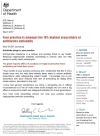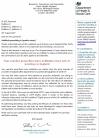Improving Our Understanding and Practice of Antibiotic Prescribing: A Study on the Use of Social Norms Feedback Letters in Primary Care
- PMID: 33807716
- PMCID: PMC7967541
- DOI: 10.3390/ijerph18052602
Improving Our Understanding and Practice of Antibiotic Prescribing: A Study on the Use of Social Norms Feedback Letters in Primary Care
Abstract
In the UK, 81% of all antibiotics are prescribed in primary care. Previous research has shown that a letter from the Chief Medical Officer (CMO) giving social norms feedback to General Practitioners (GPs) whose practices are high prescribers of antibiotics can decrease antibiotic prescribing. The aim of this study was to understand the best way for engaging with GPs to deliver feedback on prescribing behaviour that could be replicated at scale; and explore GP information requirements that would be needed to support prescribing behaviour change. Two workshops were devised utilising a participatory approach. Discussion points were noted and agreed with each group of participants. Minutes of the workshops and observation notes were taken. Data were analysed thematically. Four key themes emerged through the data analysis: (1) Our day-to-day reality, (2) GPs are competitive, (3) Face-to-face support, and (4) Empowerment and engagement. Our findings suggest there is potential for using behavioural science in the form of social norms as part of a range of engagement strategies in reducing antibiotic prescribing within primary care. This should include tailored and localised data with peer-to-peer comparisons.
Keywords: antibiotics; feedback; prescribing behaviour; primary care; social norms.
Conflict of interest statement
The authors declare no conflict of interest.
Figures




Similar articles
-
The effectiveness of repeating a social norm feedback intervention to high prescribers of antibiotics in general practice: a national regression discontinuity design.J Antimicrob Chemother. 2019 Dec 1;74(12):3603-3610. doi: 10.1093/jac/dkz392. J Antimicrob Chemother. 2019. PMID: 31539423
-
Provision of social norm feedback to high prescribers of antibiotics in general practice: a pragmatic national randomised controlled trial.Lancet. 2016 Apr 23;387(10029):1743-52. doi: 10.1016/S0140-6736(16)00215-4. Epub 2016 Feb 18. Lancet. 2016. PMID: 26898856 Free PMC article. Clinical Trial.
-
Promoting rational antibiotic therapy among high antibiotic prescribers in German primary care-study protocol of the ElektRA 4-arm cluster-randomized controlled trial.Implement Sci. 2022 Oct 4;17(1):69. doi: 10.1186/s13012-022-01241-4. Implement Sci. 2022. PMID: 36195897 Free PMC article.
-
Reducing antibiotic prescribing in Australian general practice: time for a national strategy.Med J Aust. 2017 Nov 6;207(9):401-406. doi: 10.5694/mja17.00574. Med J Aust. 2017. PMID: 29092694 Review.
-
Antibiotic prescribing for acute respiratory tract infections in primary care: an updated and expanded meta-ethnography.Br J Gen Pract. 2018 Sep;68(674):e633-e645. doi: 10.3399/bjgp18X697889. Epub 2018 Jun 18. Br J Gen Pract. 2018. PMID: 29914880 Free PMC article.
Cited by
-
Using text and charts to provide social norm feedback to general practices with high overall and high broad-spectrum antibiotic prescribing: a series of national randomised controlled trials.Trials. 2022 Jun 18;23(1):511. doi: 10.1186/s13063-022-06373-y. Trials. 2022. PMID: 35717262 Free PMC article.
-
A systematic review of national interventions and policies to optimize antibiotic use in healthcare settings in England.J Antimicrob Chemother. 2024 Jun 3;79(6):1234-1247. doi: 10.1093/jac/dkae061. J Antimicrob Chemother. 2024. PMID: 38507232 Free PMC article.
-
Clinician acceptability of an antibiotic prescribing knowledge support system for primary care: a mixed-method evaluation of features and context.BMC Health Serv Res. 2023 Apr 14;23(1):367. doi: 10.1186/s12913-023-09239-4. BMC Health Serv Res. 2023. PMID: 37060063 Free PMC article.
References
-
- O’Neill J. Tackling Drug-Resistant Infections Globally: Final Report and Recommendations. HM Government; London, UK: 2016. Review on Antimicrobial Resistance.
-
- PHE English Surveillance Programme for Antimicrobial Utilisation and Resistance (ESPAUR) [(accessed on 23 March 2020)];2019 Available online: www.facebook.com/PublicHealthEngland.
Publication types
MeSH terms
Substances
LinkOut - more resources
Full Text Sources
Other Literature Sources
Medical

